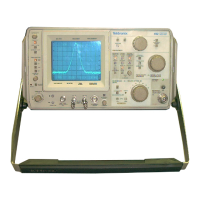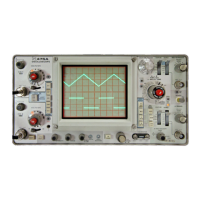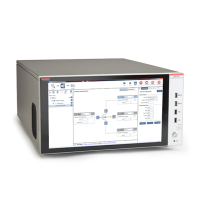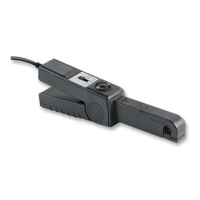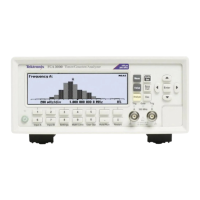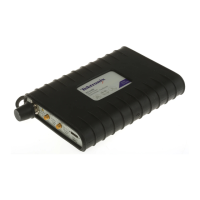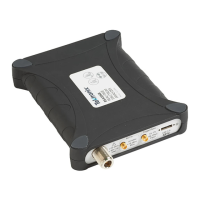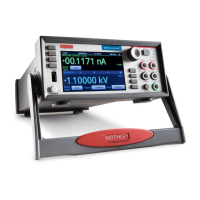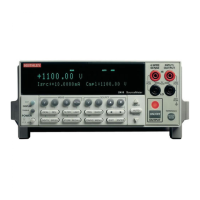and D1016, is configured as a voltage doubler. The circuit
provides approximately -3700 volts for the cathode of
the CRT and is the reference voltage for the half-wave rectifier
D1020, which develops an additional -150 volts (approxi-
mately) for the CRT grid to cathode bias.
A sample of the high voltage is taken from the voltage
divider circuit and applied to an error sensing and amplifier
circuit, Q1000, Q1001 and Q1002. This circuit controls the
current through the high voltage oscillator to regulate the
high voltage output.
Q1003, with the primary windings of T1010 plus the dis-
tributed circuit capacitance, comprise the high voltage oscil-
lator. Q1002, in shunt with the emitter-base winding of the
oscillator, regulates the oscillator current.
Q1000 compares a sample of the high voltage with the
-10 volt regulated supply. The error voltage is amplified
through the complementary amplifier and regulator Q1001
and Q1002.
The emitter of Q1002 or output of the regulator is con-
nected through R1009 to the +10 volt supply, This provides
the initial forward bias to the base of Q1003. Positive feed-
back from the collector winding to the base-emitter wind-
ing causes the circuit to oscillate. Frequency of oscillation
is dependent on transformer winding capacitance, including
reflected reactance of the secondary windings, Frequency
of oscillation is approximately 50 kHz.
The voltages supplied by the secondary windings of T1010
are: +175 V for the +150 volt regulator circuit in the low
voltage power supply; -3700 V for the CRT cathode; 6.3
VAC for the CRT heater, and grid bias voltage for the
CRT. All of these voltages are regulated by the regulator
circuit. The amplitude of the oscillator output signal, or
the transformer primary voltage, is dependent on drive
voltage to the base of Q1003. The DC base voltage of
Q1003 is set by the base voltage of Q1002.
The HV Adjust R1001 sets the forward bias for the am-
plifier Q1000. This sets the current through Q1001 and
Q1002. Far example: A decrease in the high voltage load
(current demand decreases) will decrease the forward bias
of Q1000 and a positive-going signal is applied to the base
of Q1001. This decreases the DC voltage at the base of
Q1003. The feedback therefore decreases the oscillator out-
put and the output high voltage will remain constant, Ripple
reduction is a factor of the amplifier gain.
R1032 (Intensity Range) and R1033 (INTENSITY level con-
trol) provide a range from 0 to approximately 100 volts
bias for the CRT to vary the CRT beam current. FOCUS
R1028 and ASTIGMATISM R1038 controls provide a variable
positive (with respect to the cathode) control voltage to the
focusing anode and astigmatism grid. These two controls
are normally adjusted in sequence for optimum beam focus
over the CRT graticule area.
Trace Rotation.
The Trace Rotation control provides
means to align the horizontal trace on the CRT with the
graticule lines. The Trace Rotation adjustment R1035 varies
the magnetic field about the coil around the CRT. It will
rotate the horizontal beam approximately +3°.
Blanking Circuit. Blanking in this CRT is dependent on
the voltage difference between the deflection blanking plates.
When the voltage difference between the plates is significant,
few electrons strike the phosphor and the CRT is blanked,
The voltage on one defection blanking plate (pin 9) is
fixed at approximately +80 volts by the voltage divider
R1040-R1042. The voltage on the other plate (pin 7) is de-
pendent on the output level of the operational amplifier
Q1080 and Q1081.
The quiescent level (no-trace period) of Q1080 collector
is about +10 V and the electron stream from the cathode of
the CRT is deflected to the side because of the voltage dif-
ference between the plates, No beam or trace is visible on
the screen. During sweep time, a negative unblinking pulse
is applied to the base of Q1081 This raises the operational
amplifier DC output level to the voltage level on the other
blanking plate so the electron stream can now poss through
to the CRT screen, The beam or trace is now visible.
Intensifier Circuit. Signal intensification or hose line
suppression provides increased contrast between spectrum
signals and the baseline of the display.
The video signal is applied through diodes D1050 and
D1051 to one side of a comparator amplifier Q1050 and
Q1051. The input video signal is compared against a DC
level set by the INTENSIFIER control R1013 and the resultant
differential output is applied across the base-emitter junction
of Q1070.
The positive-going input video from the detector circuit
produces an output voltage from the comparator amplifier
which will decrease the forward bias of Q1070. This produces
a negative-going voltage at the collector of Q1070. This
voltage is applied through the CONTRAST control R1075 to
the input of the operational amplifier Q1081 ond Q1080. A
negative-going signal from the intensifier circuit adds to the
unblinking voltage signal and modulates the CRT blanking
plates so that the CRT beam is intensity modulated (Z axis
modulation),
Diode D1073 provides a reference voltage to ground for
the collector of Q1070. With no signal input, the collector
potential of Q1070 is approximately +10 volts, The IN-
TENSIFIER control sets the quiescent current through the
intensifier circuit, which sets the DC level at which intensifica-
tion begins, CONTRAST control R1075 adjusts the amplitude
of the moduating signal to the unblinking circuit. This deter-
mines the contrast between the suppressed baseline and the
video signal.
Low Voltage Power Supply
The low voltage power supply in the Type 491 (see Power
Supply schematic diagram) consists of three inter-related sup-
plies that operate together as a system. This system delivers
regulated and filtered voltages of -10, +10 and +150
volts, A common power transformer T900 supplies the input
power to each of the supplies. The input circuit to the power
transformer primary can be altered so the Type 491 will
operate through a voltage range from 90 VAC to 136 VAC.
A second plug-in connector switches the transformer primary
winding from 115 V nominal to 230 V nominal line voltage
by connecting the windings in series for 230 VAC operation
or in parallel for 115 VAC operation, The Operating section
of the manual describes connector switch positions for each
voltage range. Unless otherwise specified, the Type 491 is
shipped with T900 connected for 115 VAC input.
3-14

